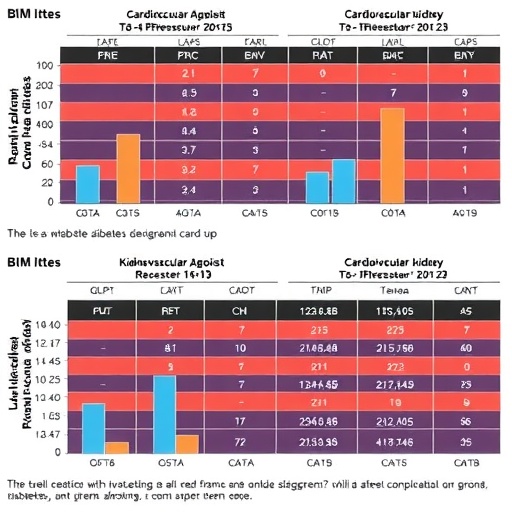In a groundbreaking cohort study published in JAMA Network Open, researchers have unveiled compelling evidence underscoring the nuanced cardiovascular and renal benefits of glucagon-like peptide-1 receptor agonists (GLP-1 RAs) among patients with type 2 diabetes mellitus. This investigation sheds new light on the critical role of body mass index (BMI) as a determinant of therapeutic efficacy, suggesting an evolution in personalized medicine strategies tailored to diabetic populations.
GLP-1 receptor agonists have been central to the pharmacological landscape of type 2 diabetes management, primarily for their glucose-lowering properties and favorable effects on weight reduction. However, the extent to which these agents confer cardiovascular and renal protection across varying BMI strata has remained an area of uncertainty. This cohort study, with a robust longitudinal design, aimed to elucidate these complex interactions and provide data-driven guidance for clinicians.
The research delineated a BMI-dependent pattern of cardiovascular benefits associated with the use of GLP-1 RAs, revealing amplified protective effects in patients presenting with higher BMI categories. Such stratification emphasizes the heterogeneity of treatment responses and the necessity to consider patient phenotypes beyond glycemic indices alone. The mechanistic underpinnings likely involve metabolic modulation, anti-inflammatory pathways, and hemodynamic regulation, potentiated by receptor activation in multiple organ systems.
Concomitantly, the study highlighted consistent renoprotective outcomes attributable to GLP-1 RA therapy regardless of BMI classification, a finding of considerable relevance given the prevalence of diabetic nephropathy as a leading cause of end-stage renal disease. These renal benefits may stem from improved glycemic control, reduced intraglomerular pressure, and attenuation of fibrotic processes—mechanisms intricately linked to receptor-mediated signaling cascades.
Employing rigorous statistical methodologies appropriate for observational research, including adjustment for confounders and stratified analyses, the investigators provided robust data supporting the differential yet complementary cardiovascular and kidney effects. Such methodological precision enhances the validity of translating these findings to clinical practice.
The interplay between BMI and the pharmacodynamics of GLP-1 RAs invites further exploration into receptor expression variability and downstream signaling efficiency. For instance, adiposity-associated alterations in GLP-1 receptor density or post-receptor signaling may modulate therapeutic responsiveness. Understanding these biological nuances could inspire future pharmacogenomic and biomarker-driven approaches.
This study also indirectly advances the discourse on individualized treatment algorithms in type 2 diabetes, highlighting that a one-size-fits-all prescription of GLP-1 RAs may obscure optimal patient outcomes. Instead, clinicians are encouraged to incorporate BMI measurements as a stratification tool when considering GLP-1 RA initiation and expected cardiovascular benefit.
Beyond the clinical arena, these findings possess significant implications for health policy and resource allocation, especially in populations burdened by obesity and diabetes comorbidity. Tailoring interventions based on BMI not only promises improved patient prognoses but may also enhance cost-effectiveness and healthcare system sustainability.
Moreover, these revelations prompt a more holistic understanding of diabetes management, wherein metabolic, cardiovascular, and renal axes are viewed as interconnected systems influenced by pharmacotherapies through complex biochemical interactions. GLP-1 RAs, by virtue of their receptor activation profiles, represent a quintessential example of pleiotropic agents capable of modifying multiple disease pathways.
Future research endeavors might build upon this foundational cohort data by integrating randomized controlled trials focused explicitly on BMI-based subgroup analyses, elucidating causality and refining clinical guidelines. In parallel, mechanistic studies probing molecular alterations within adipose tissue, vascular endothelium, and renal parenchyma may unravel the precise biological mechanisms at play.
In a landscape where precision medicine is rapidly gaining ground, this study signifies a pivotal step toward optimizing type 2 diabetes treatment frameworks. By aligning pharmacotherapy with patient-specific anthropometric and metabolic characteristics, the healthcare community moves closer to realizing tailored therapeutic regimens that maximize efficacy while minimizing adverse outcomes.
In conclusion, the association between GLP-1 receptor agonist use and BMI-dependent cardiovascular benefits, paired with consistent renal protection, heralds a paradigm shift in diabetes care. This nuanced understanding equips clinicians, researchers, and policymakers with critical insights necessary for refining treatment strategies that honor the complexity of patient physiology and disease.
Subject of Research: The study investigates the cardiovascular and renal effects of glucagon-like peptide-1 receptor agonists (GLP-1 RAs) in relation to body mass index (BMI) among patients with type 2 diabetes.
Article Title: Not specified in the provided content.
Keywords: Agonists, Cardiovascular disorders, Peptides, Kidney, Type 2 diabetes, Body mass index, Decision making, Medical treatments, Receptor activation, Cohort studies




